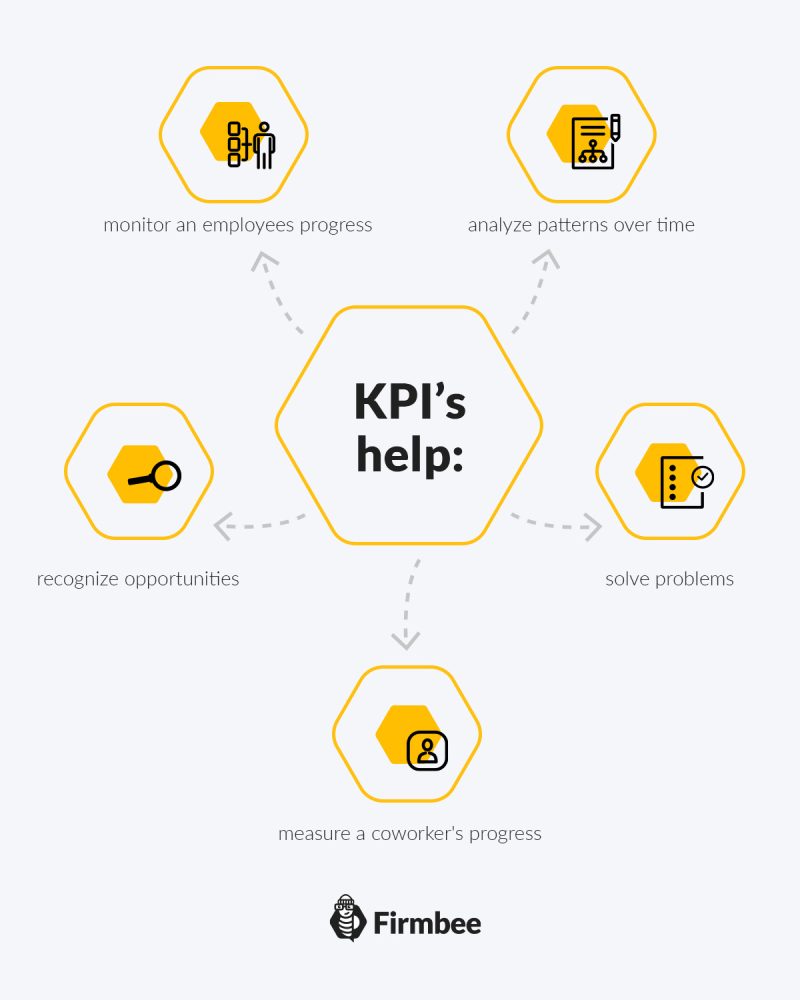KPI, as a set of indicators to study and analyze employee performance is popular in business and allows to evaluate various set values. In the case of measurable metrics, the study is much simpler, the matter is much more difficult when evaluating factors that are difficult to quantify. To measure the productivity of a person working on a conveyor belt is simple, it is enough to count the number of items produced. Also in the case of drivers, the number of kilometers driven is also countable. What about mental work? Should we consider the number of writings, projects, ideas? It is not as obvious as it seems, yet it is possible. Let’s learn how and put it into practice.
Are KPIs a good solution for evaluating employee performance? – table of contents:
- What is a KPI
- How do you measure productivity?
- Sample KPIs
- Monitoring and evaluation of indicators
- Benefits of KPIs for employees and the organization
- The most common mistakes related to the use of KPIs
- Summary
What is a KPI
KPI – key performance indicators. It is a fairly simple tool particularly useful for managers to examine virtually any area of the organization. It is a compilation of different types of metrics for assessing the level of efficiency of operations, in terms of all tangible and intangible resources, including human capital.
KPIs allow you to identify the factors that contribute to the success of the organization and those that represent the weak link. The essence of the correct use of indicators is the definition of an appropriate set, corresponding to the goals and needs of the organization. Incompetent use of KPIs will not translate into the real condition of the enterprise and will falsify the results.
How do you measure productivity?
Before we undertake to measure the productivity of tasks performed, we should first consider what work productivity is. In business practice, we define it as the sum of products or services produced, realized by one employee in a certain unit of time. Productivity is influenced by many internal factors such as material resources (equipment, facilities), new technologies, skill level and knowledge of personnel, and external factors such as market fluctuations. We can calculate labor productivity based on a simple mathematical formula:
Productivity = output/input
This means that productivity is the quotient of output (goods or services) and labor input. Using this formula, you can also count the individual rate per employee.
The selection of appropriate KPIs depends on the model and structure of the industry. Assign each gauge a numerical value that will directly enable analysis of the result obtained.
Sample KPIs
- Customer service employee – the number of complaints accepted, the number of acquired new customers,
- Call center employee – number of calls, average call time,
- Salesman – average receipt, sales of high-margin goods/services,
- Mechanic – number of cars repaired, average repair time,
- Seamstress – the number of garments sewn,
- Bank employee – the number of loans granted, the speed of customer service.
Monitoring and evaluation of indicators
Defining appropriate performance indicators is only the first stage of the study, the next steps are related to monitoring and evaluating them. A helpful tool for monitoring performance is a computer program for employee performance management, which allows reporting by each employee. In addition, we can link the results obtained can to the amount of compensation.
The main purpose of monitoring KPIs is to assess the effectiveness of planning. In the event that employees do not achieve the set goals, it is necessary to evaluate the incentive system, the reality of the set goals, unforeseen events (sick leave, downtime).
Benefits of KPIs for employees and the organization
- Measurable assessment of the impact of an individual’s work on the company’s bottom line,
- Alignment of the tasks performed with the company’s KPI targets,
- Making objective operational decisions,
- Adjusting the level of remuneration according to performance,
- Opportunities for employees to evaluate their own work,
- Implementation of key tasks that have the greatest impact on performance,
- Measurable job evaluation,
- Increase responsibility and independence of tasks performed.

The most common mistakes related to the use of KPIs
The first fundamental mistake made by organizations is the improper selection of indicators. When subjecting different areas of the enterprise to an analysis of labor productivity, different indicators should be used. There are no universal indicators suitable for every type of work.
It’s also important to set realistic goals to make challenges manageable. Setting exorbitant standards is counterproductive, lowering morale, job satisfaction, and thus affecting low productivity. The introduction of indicators should be consulted with the entire staff. Employees need to know how much and how they are expected to work and how much they will earn as a result. Targets must be clearly defined and understood by all so that there is a visible link between performance and pay.
When evaluating the results, take into account all factors. For instance, a shortage of parts or components for production will extend the time and quantity of goods produced. It is also a common mistake to specify too many indicators, which makes it much more difficult to objectively assess the results obtained.
Summary
When introducing KPIs in a company, it should be done in a thoughtful manner and planned down to the smallest detail. Communicate to all employees the way you measure work, point out the positive aspects. Evaluate results objectively taking into account the influence of various factors beyond the control of the staff. This is very important, because unrealistic goals together with subjective evaluation may result in destructive employee behavior and cause frequent falsification of work results.
Read also: Best ways to motivate employees in 2022
If you like our content, join our busy bees community on Facebook, Twitter, LinkedIn, Instagram, YouTube, Pinterest.
Author: Nicole Mankin
HR manager with an excellent ability to build a positive atmosphere and create a valuable environment for employees. She loves to see the potential of talented people and mobilize them to develop.














